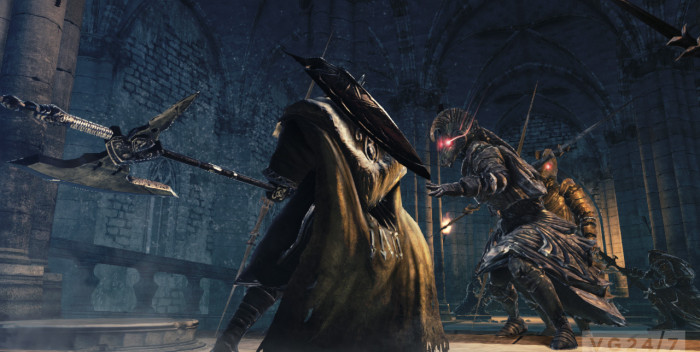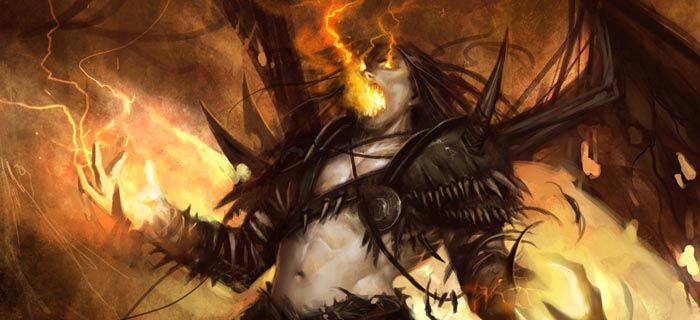Dark Souls 2 beginners guide: player vs. environment
So far, I’ve described three main reasons why Dark Souls 2 is inferior to its predecessor, but despite the tenor of those articles, I do enjoy the game immensely, for reasons which I’ll explain in future articles about why Dark Souls 2 is awesome. But you’ve come here for strategies and tactics, so you shall have them. Today we discuss the basics of PvE, or combat with the NPCs throughout the game, bosses and standard enemies alike.
No choice is the wrong one
For players used to more traditional RPG elements, the class selection screen might seem like a daunting choice. Ease your mind now: it’s not. Certain classes give tiny stat advantages that you’ll feel in the early game, sure, and others might make a certain build a little less taxing to create, but even before the game’s middle point, your initial class won’t mean much at all. Now, that doesn’t mean you should discount initial class entirely. A spellcaster build would not be so easily serve by a melee starting class, for example, though higher stats in the fighting skills might make survivability a less daunting prospect.
The point though is there’s no one right choice when starting the game. You’ll collect enough souls and items for almost any build you can think up, and points spent one way needn’t be spent in others.
A similar philosophy applies to fighting the bosses. My personal opinions aside, the first four major bosses can be fought in any order, even multiple times with something called a Bonfire Ascetic. You can call for help or go solo, but the outcome for you is the same: freedom of movement. If you find yourself struggling with The Lost Sinner, take on Old Iron King in his Iron Keep. If The Rotten smashes in your face every time, take a fly swatter to Duke’s Dear Freja, etc. etc.
Bear in mind that you are required to kill all four of the aforementioned bosses if you want to progress, so even if you nope hard at Black Gulch like I did, you’ll have to swallow your frustration and rush through. Indeed, sometimes that’s the best choice. If you don’t like something that’s going on, just get it over with quickly. Black Gulch is all but built to be serpentined through, and the Rotten’s lair is the last place you’ll need to be. The same goes for the other three Great Soul bosses. So don’t worry so much about who’s more fun to fight: you’ll fight them all, in whichever way you chose.
Dealing with mooks: those pesky insects between bosses
Never forget that when you load up Dark Souls 2, you’re in a Souls game (duh), and everything can kill you without a second thought. You are never safe, and unless you’ve mastered the game to an insane degree, you’d do well to treat every encounter like it could be your last. Even the lowly hollow warriors can, given the time, slice you into tiny little pieces. And in Dark Souls 2, you don’t just lose your souls on death. Your health drains too, returned only through a Human Effigy, a precious commodity early in the game.
So how, then, to properly approach the vast array of foes you’ll face in Drangleic? The answer comes in two parts: caution followed by brashness.
Caution: When you first encounter an enemy you’re not familiar with, do not immediately attack them if they aren’t instantly hostile to you. 99% of what you see will want your blood on sight and will pursue you within a large area near where you find them. However, if you see foes in the distance, take a couple seconds to assess how they’re equipped. Do they have allies waiting in the wings, perhaps? Is the weapon they hold glowing with some fell magic? Are they close to something you can use against them? You can tell a lot about enemies by how their dressed, how they stand, and where they’ve been placed in the world. Do not use this information lightly, but when it comes time to engage, do so with the full force of your abilities.
Brashness: If you think you have a good idea of what your enemies can do, your next task is to test your theories. Don’t run headlong into a deathtrap, but see if you can bait one or two of the buggers out. You’ll probably get a horde on your first outing, but don’t give up. Fight with everything you have, watching for attack patterns and responses to your own actions. As fits a Dark Souls title, you’ll die more than once in these learning scuffles, but be far better equipped for it. Remember that the harder you push yourself, the more you’re likely to learn.
Big bad bosses: every attack means death
Well, not exactly, but you ought to treat them that way. While I’ll cover stamina management and spacing further in my Beginner’s Guide to PvP, they bear mentioning front and center when dealing with the bosses of Dark Souls 2.
Stamina control: If you’ve never played a Souls game, here’s dodging lesson one: for several frames during your dodge, you are literally invincible. These frames occur roughly in the middle of the dodge animation, and they’re easier felt then explained. To that end, spend some time early on dodging instead of attacking. Try to tease out where the frames begin and where they end. At the same time, glance at the green bar in the top left of the screen: this is your stamina. Everything you do in Dark Souls 2, barring Estus Flask or Lifegem use, drains the gauge, and if you empty your stamina completely, it will regen at a slower rate and then only after a brief cooldown.
It should come as no surprise, then, that if you run out of stamina during a boss fight, you’re in for some hurt. Controlling stamina is all about knowing how to divide your actions between attack and defense. How many swings of that sword do you have before you run dry, and how many dodges? Budget everything you do around the answers to those questions. Getting greedy in Dark Souls gets you killed unless you’ve got some serious luck on your side. As a rule, two attacks should be the maximum against any boss. Even at baseline stamina, the should leave you enough stamina to dodge or block.
On that last note, do not neglect a shield if it’s your first go around. If you take into consideration the approximately four second period of helplessness on a shield break, even the lightest shield can save you more times than you can count. Most bosses have attacks that drain blocking stamina in around two or three hits, and your stamina recharges much slower when your guard is up, so watch out for that as well. Master dodging early as it’s usually a more reliable way of avoiding damage, but again, don’t count out a good shield.
Spacing: Practice your spacing against minor foes, but in boss fights your spacing needs to be top notch. Knowledge of attack reach comes with experience, but a good rule of thumb is to be at two weapon lengths from the boss until it’s time to attack. Every boss has at least one attack that has a cooldown period that leaves them open to attack. If you keep a safe but deadly distance, you can get to them in a couple steps, attack twice, and roll away before they can attack again.
Of course, every boss is unique, and their weapons vary in reach and speed. Plan your spacing based on what the boss’s weapon looks like. Several use great axes/swords/hammers that can hit you from what might seem like unfair distances. Unfair though it might be, learn to deal with it and adapt. Your invincibility frames apply no matter what you’re being assaulted with, be it blade or spell. Remember also that you can avoid certain attacks without the need to roll, so long as you can maneuver around the boss as the attack tracks you.
Speaking of tracking, most bosses have moves that will follow you as you move to avoid them. If you’re spaced correctly, you might avoid them altogether, but more likely than not you’ll have to get close and roll. The worst attacks are those with what’s termed a “dead angle“. The basic principle is, the main attack is done but the swing is not, and in Dark Souls damage is constant until the animation finishes completely. So if you think you avoided the giant hammer but there’s still a few frames of damage after it’s hit the ground, you might still take the full brunt of the attack. This applies to your attacks as well and you’d be wise to take advantage of it. The moral then, is it to position yourself so that you avoid even the dead angle, and these tactics come with practice and death, unfortunately.
Then again, this is Dark Souls, so what should you expect but big red letters saying “You Died.”







